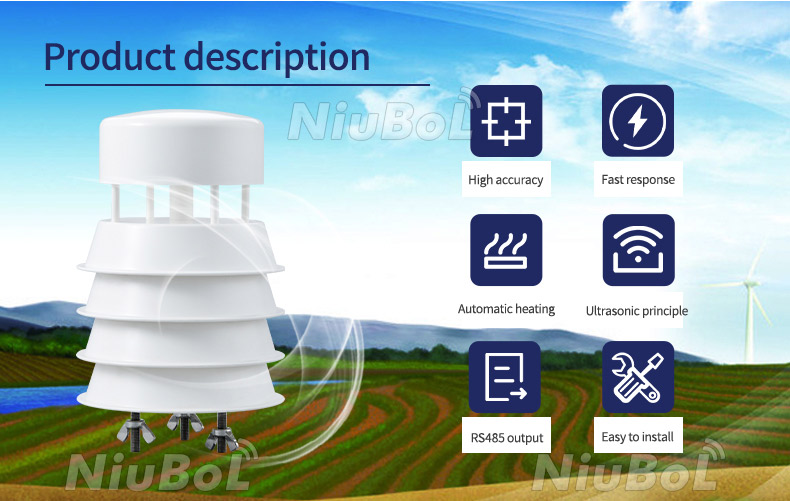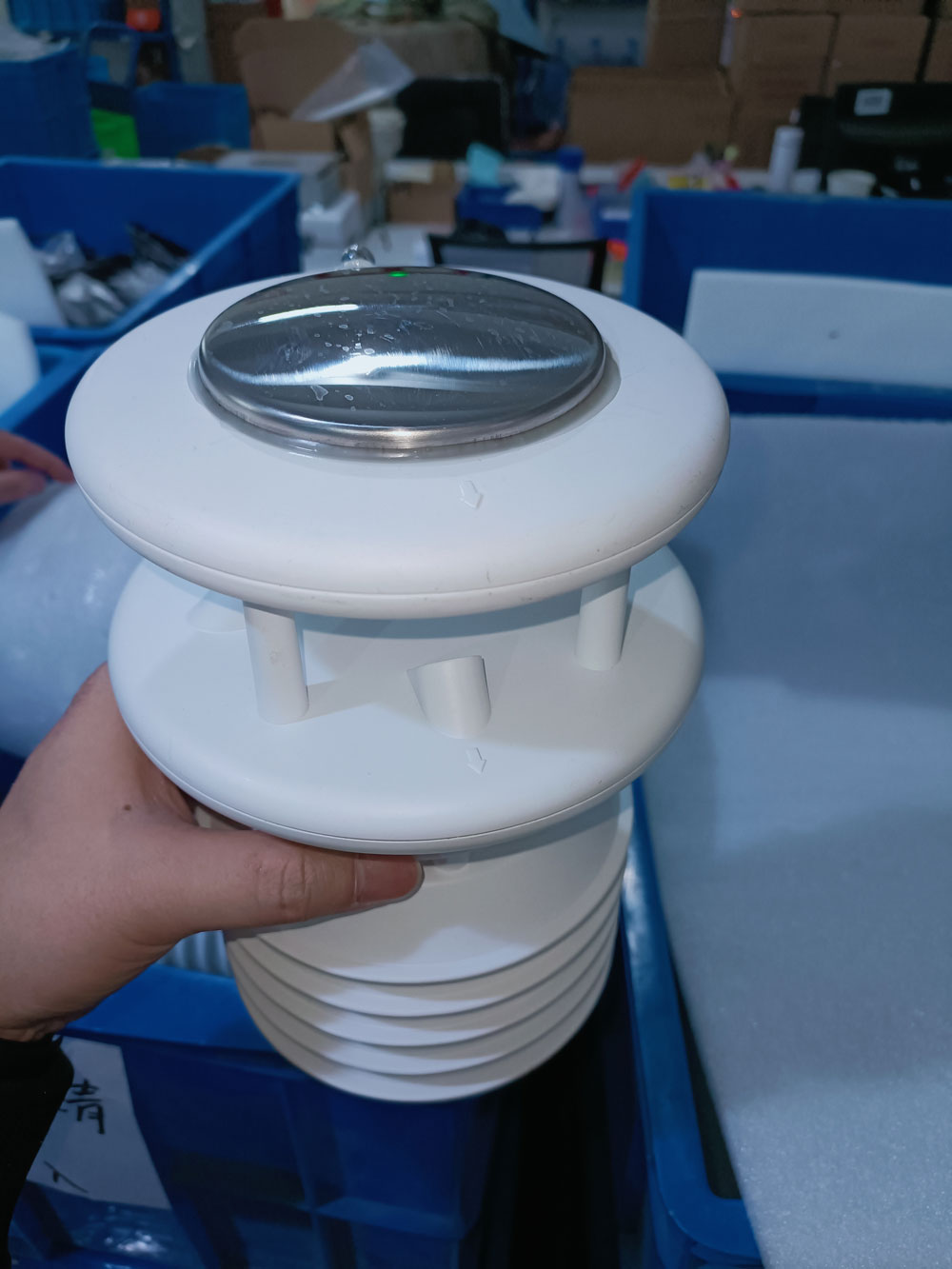

— Blogs —
—Products—
 Consumer hotline +8618073152920
Consumer hotline +8618073152920 WhatsApp:+8615367865107
Address:Room 102, District D, Houhu Industrial Park, Yuelu District, Changsha City, Hunan Province, China
Product knowledge
Time:2022-08-13 16:32:11 Popularity:1132
The ultrasonic wind speed sensor operates based on the principle of measuring the time difference of ultrasonic signals transmitted in opposite directions relative to the wind flow. This technology utilizes the properties of sound waves and the movement of air to determine the wind speed and direction.

The sensor sends out ultrasonic pulses in two directions: one aligned with the wind flow and one against it. The speed of sound in the air is influenced by the wind. When the ultrasonic signal travels in the same direction as the wind, the wind aids the sound waves, increasing the speed at which the pulse travels. Conversely, when the signal travels against the wind, the wind reduces the speed of the sound wave. By measuring the time difference for the ultrasonic waves to travel in each direction, the wind speed can be accurately calculated.
The formula for calculating wind speed based on the time difference of the ultrasonic signals is derived from the principle of relative motion. The wind speed is directly proportional to the difference in the travel time of the ultrasonic waves in both directions. Because the sensor simultaneously measures sound propagation in both directions, temperature fluctuations—known to affect the speed of sound—are effectively accounted for, minimizing their impact on the readings.
1. No Moving Parts: Unlike mechanical anemometers, ultrasonic sensors have no moving parts, which reduces wear and tear, increases durability, and eliminates maintenance needs. This feature makes ultrasonic wind speed sensors highly reliable and long-lasting.
2. High Accuracy: The sensor is highly accurate, even under challenging weather conditions. It can provide real-time data on both wind speed and direction, making it suitable for a variety of applications, including meteorology, environmental monitoring, and industrial use.
3. Weather Resistance: The lack of moving components and the design of the ultrasonic sensor allow it to operate in all weather conditions, including extreme environments. This makes it an ideal tool for both research and field use, where traditional mechanical anemometers may fail due to mechanical issues.
4. Customizable Output: The sensor can output wind speed and direction data in various formats, including digital (RS485) or analog signals. Users can choose the output format that best suits their equipment, allowing for seamless integration with computers, data collectors, or other monitoring systems. The output frequency and wind speed unit can also be adjusted according to user needs.
5. Temperature Compensation: Since the speed of sound is sensitive to temperature, the sensor's dual-channel measurement system compensates for temperature changes. This ensures accurate readings regardless of environmental temperature variations.
6. Optional Heating Device: For use in icy or subzero environments, the sensor can be equipped with a heating device. This prevents the buildup of ice on the sensor and ensures its proper function in cold climates.
7. Networked Capability: Multiple sensors can be connected in a network to monitor wind conditions over a broader area, providing real-time data for large-scale environmental monitoring systems.

- Maintenance-Free: Ultrasonic anemometers do not require regular maintenance or calibration, making them ideal for long-term deployment.
- No Mechanical Failures: Since there are no moving parts, the sensor is less prone to mechanical failures due to wind, dust, or wear and tear. This increases its lifespan and reliability.
- All-Weather Operation: Ultrasonic wind sensors are designed to operate in extreme weather conditions, including high winds, rain, snow, and freezing temperatures.

ultrasonic wind speed sensor Applications:
- Meteorology and Weather Stations: To monitor real-time wind conditions and predict weather patterns.
- Environmental Monitoring: For assessing air quality and wind conditions in urban or industrial areas.
- Aerospace and Aviation: To measure wind speeds and directions for flight planning and safety assessments.
- Renewable Energy: To measure wind speed and direction for optimizing the positioning of wind turbines.
- Marine and Offshore Applications: To measure wind speeds and directions for navigational and safety purposes.

The ultrasonic wind speed sensor is a highly advanced and reliable tool for measuring both wind speed and direction. Its advantages—such as the absence of moving parts, high durability, maintenance-free operation, and the ability to work in all weather conditions—make it a superior choice over traditional mechanical anemometers. Its precise and continuous operation under diverse conditions is why it is becoming the preferred choice in many industries and research fields. With the ability to customize outputs, compensate for temperature changes, and easily integrate into larger networks, the ultrasonic wind sensor represents a strong replacement for older, mechanical anemometers, ensuring more accurate and efficient wind monitoring for years to come.
Prev:Thermal wind speed sensor principle of operation
Next:What is the role of the farmland microclimate observation station?
Related recommendations
Sensors & Weather Stations Catalog
Agriculture Sensors and Weather Stations Catalog-NiuBoL.pdf
Weather Stations Catalog-NiuBoL.pdf
Related products
 Combined air temperature and relative humidity sensor
Combined air temperature and relative humidity sensor Soil Moisture Temperature sensor for irrigation
Soil Moisture Temperature sensor for irrigation Soil pH sensor RS485 soil Testing instrument soil ph meter for agriculture
Soil pH sensor RS485 soil Testing instrument soil ph meter for agriculture Wind Speed sensor Output Modbus/RS485/Analog/0-5V/4-20mA
Wind Speed sensor Output Modbus/RS485/Analog/0-5V/4-20mA Tipping bucket rain gauge for weather monitoring auto rainfall sensor RS485/Outdoor/stainless steel
Tipping bucket rain gauge for weather monitoring auto rainfall sensor RS485/Outdoor/stainless steel Pyranometer Solar Radiation Sensor 4-20mA/RS485
Pyranometer Solar Radiation Sensor 4-20mA/RS485
Screenshot, WhatsApp to identify the QR code
WhatsApp number:+8615367865107
(Click on WhatsApp to copy and add friends)